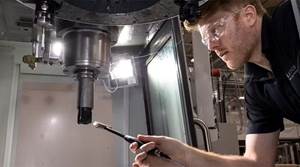CAD/CAM Converges With CNC
Both CAD/CAM systems and now CNCs have rushed to the same operating platform--the personal computer.
Share





Even though CAD/CAM and CNC are next-door neighbors in the process chain of preparing and then executing part programs, the two technologies have historically been worlds apart. CAD/CAM is supposed to be all about working directly with geometry. CNC is for controlling machines. And for the two to talk at all, geometrical intentions have to be translated into the arcane language of G and M codes to be acted out in the physical environment of the machine.
This paradigm is so fundamental to numerical control technology as we've known it that we hardly can think of it being any other way. However, as both CAD/CAM systems and now CNCs have rushed to the same operating platform--the personal computer--all the old rules are set to be broken. Add the burgeoning multimedia capabilities of the PC, and the potential of next-generation CAD/CAM/CNC technology looks most interesting indeed. A company on the forefront of this technology is CamSoft (Lake Elsinore, California) who has combined multimedia CAD/CAM and PC-based motion controllers into a single product. Now the personal computer has the capability to control the servo motors directly from the graphics shown on the CAD/CAM screen.
And that's going to require CNC shops to think very differently about the technology they've known so well all these years. Says CamSoft president Gary Corey, "It is difficult to grasp the concept that there does not have to be G code any more and that CAD/CAM graphics and motion control can be interactive in real-time. In fact, there is no code at all to deal with. No typing mistakes. No postprocessor problems. The graphics on the screen that the user draws or imports from his or her CAD system automatically becomes motion."
The CAD/CAM portion of the system runs in a Microsoft Windows operating environment. Among its more conventional features are 3D multi-surface cutting, multiple viewports, CAD links, a large database and a built-in interactive technical support button. It also provides high-resolution, graphic verification of part programs, showing the tool and workpiece as a full 3D solid model.
The multimedia aspects of the system allow text, graphics or sound to be associated with a part program. This way all sorts of job notes, setup instructions, part drawings, tool libraries or other information can be electronically delivered to the CNC on the shop floor where it can be accessed by the setup person or operator.
The PC-based motion control software and hardware toolkit allow users to create and customize their own controller for any two- to five-axis machine tool. This capability, in combination with the CAD/CAM software, allows the machine tool to work directly from workpiece geometry. The basic concept is to convert the graphic drawing--whether it is created in the system or imported via DXF, IGES, Gerber or HPGL protocols--directly to axis motion. No G-code programs need to be written or reviewed (though G-code programs can be read if necessary). And no postprocessors. Moreover, there is now effectively no limitation on program size, which should prove to be particularly important with large 3D contouring routines.
The minimum hardware requirement for the controller, says CamSoft, is a 90 MHz, Pentium computer with 40 MB of hard disk space, a 1.44 MB floppy drive, two RS-232 ports, a Super VGA color card and a joystick or trackball. No PLCs are needed.
CamSoft has a booklet that will answer all of the common questions that would normally arise when examining this new technology for the first time.
Related Content
Orthopedic Event Discusses Manufacturing Strategies
At the seminar, representatives from multiple companies discussed strategies for making orthopedic devices accurately and efficiently.
Read More4 Commonly Misapplied CNC Features
Misapplication of these important CNC features will result in wasted time, wasted or duplicated effort and/or wasted material.
Read MoreHow to Mitigate Chatter to Boost Machining Rates
There are usually better solutions to chatter than just reducing the feed rate. Through vibration analysis, the chatter problem can be solved, enabling much higher metal removal rates, better quality and longer tool life.
Read MoreThe Power of Practical Demonstrations and Projects
Practical work has served Bridgerland Technical College both in preparing its current students for manufacturing jobs and in appealing to new generations of potential machinists.
Read MoreRead Next
Machine Shop MBA
Making Chips and 91ÊÓƵÍøÕ¾ÎÛ are teaming up for a new podcast series called Machine Shop MBA—designed to help manufacturers measure their success against the industry’s best. Through the lens of the Top Shops benchmarking program, the series explores the KPIs that set high-performing shops apart, from machine utilization and first-pass yield to employee engagement and revenue per employee.
Read MoreLast Chance! 2025 Top Shops Benchmarking Survey Still Open Through April 30
Don’t miss out! 91ÊÓƵÍøÕ¾ÎÛ's Top Shops Benchmarking Survey is still open — but not for long. This is your last chance to a receive free, customized benchmarking report that includes actionable feedback across several shopfloor and business metrics.
Read MoreAMRs Are Moving Into Manufacturing: Considerations for Implementation
AMRs can provide a flexible, easy-to-use automation platform so long as manufacturers choose a suitable task and prepare their facilities.
Read More






















